Intermarkets' Privacy Policy
Donate to Ace of Spades HQ!
aceofspadeshq at gee mail.com
Buck:
buck.throckmorton at protonmail.com
CBD:
cbd at cutjibnewsletter.com
joe mannix:
mannix2024 at proton.me
MisHum:
petmorons at gee mail.com
J.J. Sefton:
sefton at cutjibnewsletter.com
The Morning Rant: The Fall Of Iran?
Mid-Morning Art Thread
The Morning Report — 12/30/25
Daily Tech News -1 January 2026
Overnight Open Thread [12/29/2025]
Icebreaker Cafe
J6 Pipebomber Says He Wanted to Hurt Both Parties
Suspect In Mass Stabbing on Paris Metro Turns Out to be... Oh But Why Spoil the Shocking Twist?
"MS-NOW's" Ratings Crash After Separation from Garbage Network NBC
Jim Sunk New Dawn 2025
Jewells45 2025
Bandersnatch 2024
GnuBreed 2024
Captain Hate 2023
moon_over_vermont 2023
westminsterdogshow 2023
Ann Wilson(Empire1) 2022
Dave In Texas 2022
Jesse in D.C. 2022
OregonMuse 2022
redc1c4 2021
Tami 2021
Chavez the Hugo 2020
Ibguy 2020
Rickl 2019
Joffen 2014
maildrop62 at proton dot me
TBD
Saturday Gardening Thread: Advanced Puttering [KT]
Greetings, gardeners and putterers! We have a few unusual topics in today's thread. Sunflowers are not all that unusual, but they can be dramatic. I really like the one above.
Here's a couple of pictures of my sunflowers. The tall one is about 10' tall. (I measured it against Mr. L who is about 6') Sunflowers are my favorites so I try to grow a few each year. They seem to love the Indiana clay soil. Other that watering, I do nothing to help them along I love the Gardening Thread and look forward to it every week. I am amazed at the beautiful gardens of the Horde. Thanks for making Saturdays so special!Mrs. Leggy
I also included a flower head that had gone to seed that my birds and squirrels enjoyed.
Advanced Puttering
The great Hank Curmudgeon sent in the following for our education and enjoyment:
Who else but me could find a "puttering" article that's about building something AND gardening at the same time, eh? CBD? No! MisHum? No! OrMuse? No! Stinky ol' Hank Curmudgeon...That's who! (Dramatic aren't I?)
We love you, Hank. Stay away from the hobos, though. It's too much.
He sent in a piece with detailed instructions on how to build a folding tricopter plant inspection gardening drone! It uses near infrared imaging to inspect plants.
At our weekend house we've a nice little garden with a lot of fruits and vegetables but sometimes it's just hard to keep up with how the plants change. They need constant supervision and they're very vulnerable to weather, infections, bugs, etc...
Here is the drone in action. What does it remind you of?
Do you remember the do-it-yourself wasp and yellow jacket trap at the end of this post? Sounds effective, but there might be a place for some drone reconnaissance in a campaign against cranky yellow jackets, too. Or maybe you just need an excuse to putter around with a drone.
Bird Dog at Maggie's Farm put up a post about yellowjackets recently, listing 6 characteristics that make them dangerous. This is number 3:
They're defensive. Yellowjackets vigorously defend their nests. They will assign a "guard" to stand watch at the nest opening and alert the colony to a threat. Swarm attacks can occur when someone accidentally steps in, hits, or even comes too close to a nest. Attacks of hundreds of yellowjackets from underground nests can also be triggered by ground vibrations - thus, mowing lawns can be hazardous during the late summer season when colonies are large.
Got a plan to prevent attack?
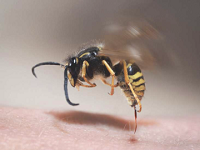
The Edible Garden?
A couple of queries from Cumberland Astro this week:
Now in my 3rd year in the mountains of Tennessee, I'm still trying to learn all the native trees and plants, which are so different from those I knew most of my life in Central Texas. One thing I'm curious about is the food that can be foraged here. I'm curious if a couple plants growing in the woods around my house are edible. On these two pictures are:1) Ferns - these ferns are growing in the woods at the back of my property. When they sprout each Spring they are rolled up tight and look like the "fiddleheads" that people forage for and eat. I'm curious if any lurker can identify if these are indeed the edible fiddleheads?
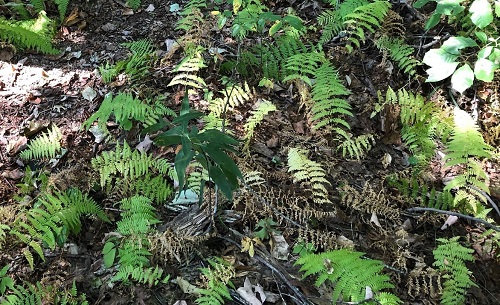
2) Berries - These berry plants are common in the woods here, and I assumed they were wild blueberries, but upon closer inspection I see that the bushes have thorns, which rules out blueberries. I then figured they must be huckleberries, but when I do image searches of huckleberries, the leaves don't look as rounded. Again, I'm curious if any lurker can identify this berry bush, and if the berries are edible.It looks like the berries are ripening to a dark blue / purple color.
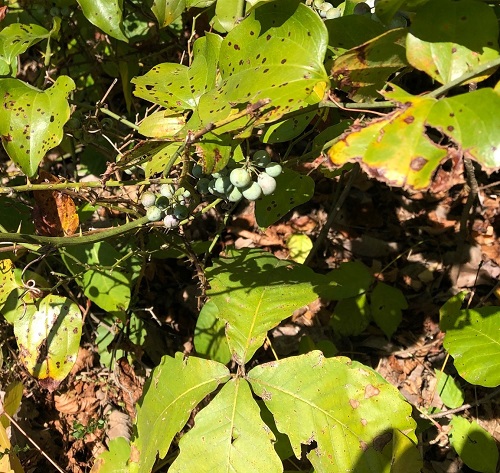
We have some foragers in The Horde. Can anybody help Cumberland Astro?
Last Week
For those who don't check the comments again on Sundays, last week our mystery plant was identified by techno as a castor bean. DON'T EAT IT.
Gordon re-posted his wife's cherished salsa recipe. With interesting notations on its name. Here's a reprise of the photo of the ingredients before processing. Mmmmm.

There is some interesting information on home canning, steam juicers and drying green beans late in the comment thread, too.
Tree Fruits
Maybe some of those food preservation tips can help out S. Lynn, who sent in photos of peaches and pears on the tree. With bonus chicken observers. CHICKEN WARNING: Maybe not so much for members of The Horde, but maybe for your friends in Napa Valley: The CDC has issued a warning to refrain from snuggling or kissing chickens. Don't want anybody infected with Salmonella. A warning for certain other friends: don't let chickens wander around the house, either. Especially the kitchen and dining room.
Anybody got a good peach or pear recipe to share? Maybe S. Lynn can offer some advice if you are looking into growing some fruit trees, or if you have one started.

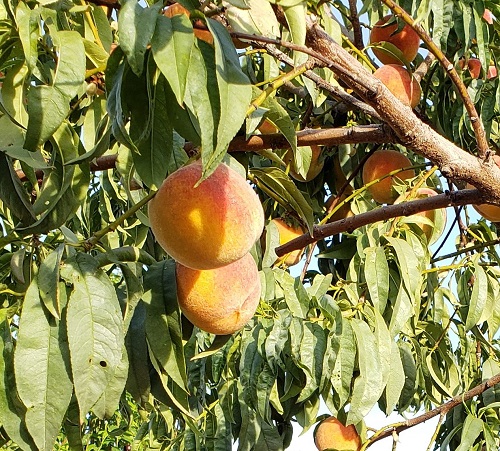
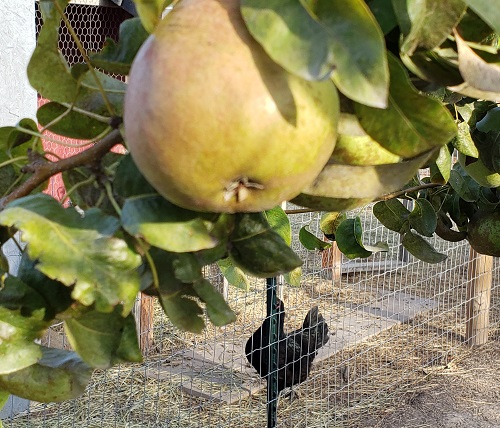
A Wheel Bug?
Hi KT, this is BeckoningChasm.I took this picture a couple of years ago; it's an insect called a Wheel Bug. It looks like it came out of a video game, and for all I know, it has made its way into a video game or two. They are very beneficial to gardens as they eat a lot of insect pests. Supposedly, the bite is painful but they are described as "shy" so that being bit might be rare. Kind of looks like she might be carrying eggs in this pic, but I don't know; they're common in the US but this is the only time I've seen one.
I always enjoy the Gardening Thread (and the Thread Before the Gardening Thread) so I thought I'd contribute.
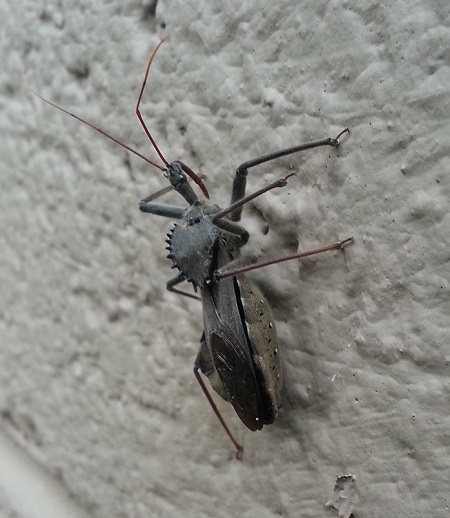
Wow. That's a bug!
Hank Curmudgeon says, "Yeah. Don't get bit by one."
The wheel bug, Arilus cristatus (Linnaeus), is a moderately common, widely distributed, beneficial assassin bug that preys on pest insects. However, its bite can be more severe than a bee sting, and both nymphs and adults should be avoided or handled with caution.
Adult: The wheel bug adult usually measures from 1 to 1.25 inches long. This assassin bug is a dark, robust creature with long legs and antennae, a stout beak, large eyes on a slim head, and a prominent thoracic, semicircular crest that resembles a cogwheel or chicken's comb. This is the only insect species in the United States with such a crest.
Bad enough being bitten by a little 1/3 inch assassin bug. I would hate to be bitten by one as big as these! Symptoms and treatment described at the link, along with life cycle photos and particulars about why this insect is valuable.
So, which is more threatening: a wheel bug or a yellowjacket?
Thanks for the great link, Hank.
Butterflies and Passion Flowers
More from Beckoning Chasm:
Here are a couple of butterfly photos taken today. According to what I can find on the web, the species is a Gulf Fritillary. As you can see, not only is the upper side of the wings quite lovely, but the underside is as well. (These are two shots of the same creature.) I had to use PhotoShop to sharpen the upper side photo, as my idiot phone decided, "Oh, you want to focus on the sidewalk! Got you covered, chief!"
Our first semi-impressionistic insect photo! Love the sort of Monet-like flower details, too. Not that we haven't had artistic photos on other threads.

This photo is also lovely, though in a more "realist" way. Those thistles have prickles! Beautiful butterfly.

Back in August, we posted another photo of a Gulf Fritillary, along with a photo of a Passion Flower, taken by Mikee in Austin. I'm not sure which one it is, but I think it has P. caerulea in its background. Maybe Blue Bouquet? P. caerulea (the Blue Crown Passion Flower) is one of the Passion Flowers that Gulf Fritillaries like to lay eggs on (in preference, say, to the species normally grown for fruit or to the showy red kind). There is a fragrant white variety of the Blue Crown, too. This species has edible fruit with that looks kind of like an apricot with seedy red pulp. Not real tasty. P. alato-caerulea, a common hybrid, is less prone to caterpillars. Don't know about the flower photographed by Mikee. But he says that Gulf Fritillaries often encounter his truck windshield.
Passion flower plants have developed a number of defenses against butterfly caterpillars. In addition to growing fast. Fake butterfly eggs, thick leaves, little leaves that drop off when a butterfly lays an egg, and more. The caterpillars can nearly strip a plant of its leaves if there are enough of them.
The showiest native passionflower in the USA is the Maypop. It is one of the natural larval foods of the Gulf Fritillary Butterfly. It is root-hardy quite far to the north, beyond the range where Gulf Fritillaries normally fly in the summer. Logee's Greenhouse is in Connecticut. Look how big this plant gets over summer, in the video below. It is considered a weed in many parts of the East. But it can be valuable in the right location. Stabilizes hillsides.
This unusual flower is widely distributed in the Southeast, especially from Florida to Texas. The plants were given the name Passionflower or Passion vine because the floral parts were once said to represent aspects of the Christian crucifixion story, sometimes referred to as the Passion. The 10 petal-like parts represents the disciples of Jesus, excluding Peter and Judas; the 5 stamens the wounds Jesus received; the knob-like stigmas the nails; the fringe the crown of thorns.
The fruits are edible, but lack the intense tropical flavor of "passion fruit", which comes from a different species. I can't say if the common name "Maypop" comes from its late emergence in Spring (in May?) or from the sound of the fruit popping when you step on one. The plant has been used medicinally, and people still make tea from the flowers or the plant (watch for cyanide).
Butterflies which lay eggs on this the Maypop in the USA are listed as Gulf Fritillary, Zebra Longwing, Crimson-patch Longwing, Julia butterfly, Mexican Butterfly, Red-banded hairstreak, Banded Hairstreak and Variegated Fritillary. I'm pretty sure that the first four use passion flower plants exclusively as larval food sources. I don't know what the "Mexican Butterfly" is. Among the passion flower butterflies, I found a "Mexican Longwing", but it doesn't range into the USA, and a Mexican Fritillary, which comes into Texas and Arizona in the summer. It resembles the Variegated Fritillary. Maybe that's the "Mexican Butterfly".
You can bring Gulf Fritillary caterpillars indoors to raise them into butterflies in the summer, if you live where they do. Nice life cycle photos here. Because of the way the caterpillars often wave their heads around, they sometimes remind me of little Chinese dragons ready for a parade. The spikes are harmless. Gulf Fritillaries are quite bold around people in the garden. Cheerful to have around.
The Gulf Fritillary occurs throughout the southern United States southward through Mexico, Central America and the West Indies to South America. In Florida, it can be found in all 67 counties. The butterfly undergoes distinct seasonal movements each year. Adults move northward in spring and form temporarily breeding colonies throughout the southeast. Individual vagrants may occasionally reach into the central U.S., but rarely into the Midwest. Starting in late summer and continuing through fall, huge numbers of adults migrate southward into peninsular Florida. Adults overwinter in frost-free portions of their range.
The Gulf Fritillary also lives in some parts of the Southwest where people have planted passion flowers, like coastal California.
Don't try to overwinter caterpillars.
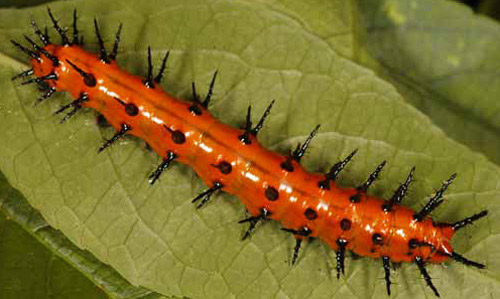
The Variegated Fritillary has characteristics similar to both the Gulf Fritillary and to the true Fritillaries of North America which use violets as larval food. Its caterpillars can feed on both passion flowers and violets. And on some other plants as well. Even purslane. It has a much wider range in the USA than the Gulf Fritillary. Its caterpillar looks fancier. Its chrysalis looks much fancier than that of the Gulf Fritillary. Must not need to resemble a dead leaf for some reason. This does not look like camouflage:
The chrysalis of the Variegated Fritillary is a shiny, pearl-colored white, and looks like an expensive piece of jewelry!It is mottled with small black and brown spots and streaks, along with rows of shiny gold spikes.
Earrings?
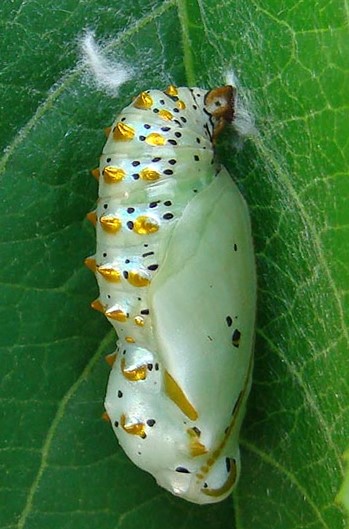
Variegated Fritillaries have variable size and appearance as adults, 1 3/4 - 3 1/8 inches. See the representative photo below. They are reportedly more skittish around people than the Gulf Fritillary.
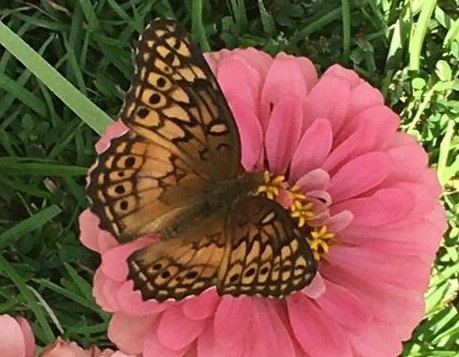
For years, I have wanted a hybrid of the Maypop with an Argentinian species of passion flower that is supposed to be quite hardy. It is said to produce fruit with fragrant, tasty pulp. The flowers are reputed to smell like sweet peas. Let's see what a dedicated butterfly gardener has to say about it. There are also a couple of delightful garden dog photos at the link:
This is Passiflora 'Incense.' Now I try to grow native as much as possible but when I saw this striking purple color and smelled the beautiful flower, I had to have it! It has such a wonderful fragrance. This passionflower is a hybrid of Passiflora incarnata (which is Native) and Passiflora cinnicata. Some of you may recognize Passiflora incarnata as Maypop. P. 'Incense' is a fast growing vine that tolerates sun or shade and flowers from spring through summer. Sometimes people are hesitant to plant passionflower when I suggest it for their butterfly gardens because it grows so vigorously. I planted mine in a pot and it is doing great. There are lots of flowers and it has successfully attracted Gulf Fritillaries. We found 3 caterpillars munching on its leaves this week!
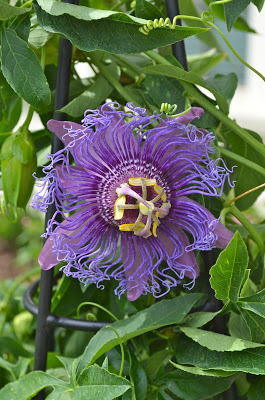
The flowers can grow to 5 inches across. Root hardy to 0 degrees F.
If you would like to send information and/or photos for the Saturday Gardening Thread, the address is:
ktinthegarden
at g mail dot com
Include your nic unless you want to remain a lurker.
Bertram Cabot, Jr.: "I remember who I am but I forgot who I was. ..."
The Rank Organization: "This thread does smell better, at least so far. ..."
[/i][/b]Clyde Shelton: "Christian Collins @CollinsforTX In February, Il ..."
Bulg: "Biden's Dog, did you get any of the snow that hit ..."
garrett: "Have you seen the Tweaker Geographic Channel on yo ..."
Martini Farmer: "Incitement to violence is a Democrat party plank. ..."
tubal: "Doing well. How are you, Ace?? Wishing you a Happy ..."
Pudinhead: "415 We spent 2 trillion in Iraq for their fake nuk ..."
Sponge - F*ck Cancer: "Karoline Leavitt pulls the pin and lobs a nade in ..."
[/i][/b]Clyde Shelton: "Eric Daugherty @EricLDaugh FACT: James O'Keefe ..."
Biden's Dog sniffs a whole lotta malarkey, : "How is everyone?! Posted by: Ace at 12:31 PM - ..."
The Morning Rant: The Fall Of Iran?
Mid-Morning Art Thread
The Morning Report — 12/30/25
Daily Tech News -1 January 2026
Overnight Open Thread [12/29/2025]
Icebreaker Cafe
J6 Pipebomber Says He Wanted to Hurt Both Parties
Suspect In Mass Stabbing on Paris Metro Turns Out to be... Oh But Why Spoil the Shocking Twist?
"MS-NOW's" Ratings Crash After Separation from Garbage Network NBC
Paul Anka Haiku Contest Announcement
Integrity SAT's: Entrance Exam for Paul Anka's Band
AllahPundit's Paul Anka 45's Collection
AnkaPundit: Paul Anka Takes Over the Site for a Weekend (Continues through to Monday's postings)
George Bush Slices Don Rumsfeld Like an F*ckin' Hammer
Democratic Forays into Erotica
New Shows On Gore's DNC/MTV Network
Nicknames for Potatoes, By People Who Really Hate Potatoes
Star Wars Euphemisms for Self-Abuse
Signs You're at an Iraqi "Wedding Party"
Signs Your Clown Has Gone Bad
Signs That You, Geroge Michael, Should Probably Just Give It Up
Signs of Hip-Hop Influence on John Kerry
NYT Headlines Spinning Bush's Jobs Boom
Things People Are More Likely to Say Than "Did You Hear What Al Franken Said Yesterday?"
Signs that Paul Krugman Has Lost His Frickin' Mind
All-Time Best NBA Players, According to Senator Robert Byrd
Other Bad Things About the Jews, According to the Koran
Signs That David Letterman Just Doesn't Care Anymore
Examples of Bob Kerrey's Insufferable Racial Jackassery
Signs Andy Rooney Is Going Senile
Other Judgments Dick Clarke Made About Condi Rice Based on Her Appearance
Collective Names for Groups of People
John Kerry's Other Vietnam Super-Pets
Cool Things About the XM8 Assault Rifle
Media-Approved Facts About the Democrat Spy
Changes to Make Christianity More "Inclusive"
Secret John Kerry Senatorial Accomplishments
John Edwards Campaign Excuses
John Kerry Pick-Up Lines
Changes Liberal Senator George Michell Will Make at Disney
Torments in Dog-Hell
The Ace of Spades HQ Sex-for-Money Skankathon
A D&D Guide to the Democratic Candidates
Margaret Cho: Just Not Funny
More Margaret Cho Abuse
Margaret Cho: Still Not Funny
Iraqi Prisoner Claims He Was Raped... By Woman
Wonkette Announces "Morning Zoo" Format
John Kerry's "Plan" Causes Surrender of Moqtada al-Sadr's Militia
World Muslim Leaders Apologize for Nick Berg's Beheading
Michael Moore Goes on Lunchtime Manhattan Death-Spree
Milestone: Oliver Willis Posts 400th "Fake News Article" Referencing Britney Spears
Liberal Economists Rue a "New Decade of Greed"
Artificial Insouciance: Maureen Dowd's Word Processor Revolts Against Her Numbing Imbecility
Intelligence Officials Eye Blogs for Tips
They Done Found Us Out, Cletus: Intrepid Internet Detective Figures Out Our Master Plan
Shock: Josh Marshall Almost Mentions Sarin Discovery in Iraq
Leather-Clad Biker Freaks Terrorize Australian Town
When Clinton Was President, Torture Was Cool
What Wonkette Means When She Explains What Tina Brown Means
Wonkette's Stand-Up Act
Wankette HQ Gay-Rumors Du Jour
Here's What's Bugging Me: Goose and Slider
My Own Micah Wright Style Confession of Dishonesty
Outraged "Conservatives" React to the FMA
An On-Line Impression of Dennis Miller Having Sex with a Kodiak Bear
The Story the Rightwing Media Refuses to Report!
Our Lunch with David "Glengarry Glen Ross" Mamet
The House of Love: Paul Krugman
A Michael Moore Mystery (TM)
The Dowd-O-Matic!
Liberal Consistency and Other Myths
Kepler's Laws of Liberal Media Bias
John Kerry-- The Splunge! Candidate
"Divisive" Politics & "Attacks on Patriotism" (very long)
The Donkey ("The Raven" parody)

